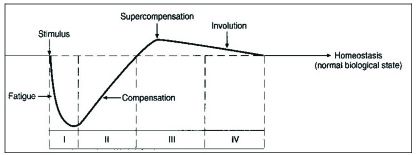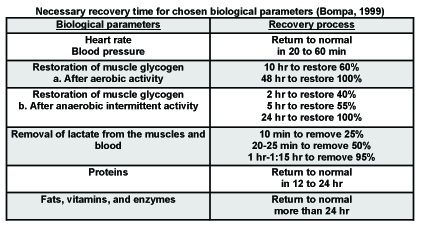May 07, 2011 – Speaking of a workout, an athlete has only two ways to run it: correctly or incorrectly. Of course none of us investing precious time into regular training would like to belong to the “incorrect” group. Whether we are weekend warriors or high performance athletes, we want to reduce training errors to a minimum. The first step in this direction should be to set up a decent training plan. To do this we need to understand the leading concept of training – the supercompensation cycle.
Living beings have a gift – it’s called regeneration. Although we can’t re-grow a whole limb as some creatures can, we do have a considerable regeneration capacity. You bet if regeneration were not encrypted in our genes we could easily bleed to death just by scratching our knee. From this viewpoint, a workout can be considered as controlled bodily harm and “post-training regeneration” is not different from the scratched-skin healing process.
Physical activity, also called physical stress, disturbs visceral organism equilibrium (homeostasis). There is depletion of energy resources such as glycogen supported by working enzymes, hormones, or oxygen from red blood cells. There is physical damage such as micro-ruptures of muscle fibers, initiation of muscle, tendon and joint inflammation etc. This represents the first stage of the whole training process. To bring homeostasis back to the starting point, in other words to recuperate from the stress, we must pass through stage number two.
Common sense says it will be a stage of rest. There are several choices. One of them is complete passivity, one is another physical activity done at low intensity, and the most effective one is a mix of active regeneration and invasive recovering procedures.
During the rest stage, the human body is experiencing the process called adaptation, the process in which the organism prepares for a new experience (and for a new stress). With adequate earlier training, adaptation embraces glycogen restoration and increase of enzyme activity and hormone redistribution (some are inhibited, some excreted) and, in the longer term, muscle mass growth, enhanced muscular innervation, blood vessel multiplication, or blood volume increase including red cell multiplication.
Further there is an improvement of oxygen utilization as well as its economy, both enhancing respiratory capacity; next is cardiac hypertrophy increasing cardiac capacity; and, specifically in youth, there is bone growth stimulation and bone density increase. We should also not overlook adaptation at the psychological level such as improved tolerance of physical pain and of psychological stress, and enhanced self-control and willpower.
In reality if we train in proportion to our capacity and skills, correctly rehydrate and replenish food and its supplements during and right after a workout, and set an appropriate rest time for the post-workout recovery phase again accompanied by proper nutrients and hydration, then Mother Nature can work her miracles. What exactly is going to happen? The body remembers the last stress with which it battled. Not only does it compensate and return to its original state but it overloads to a higher level: the body supercompensates.
Supercompensation Curve
 As we can read from the supercompensation curve, the actual training time (phase I on the curve) represents only a short fragment of the whole process compared to the remaining length of the post-training adaptation (phases II, III, IV). The following chart shows that individual recovery processes may take from a couple of minutes to many hours, even days. One of the shortest recovery processes occurs in muscles – lactic acid removal – and lasts just a few minutes. Other biological parameters show significantly longer recovery times, while the restoration of glycogen, the main aerobic energy resource, can extend the time of compensation (and then supercompensation) up to a couple of days.
As we can read from the supercompensation curve, the actual training time (phase I on the curve) represents only a short fragment of the whole process compared to the remaining length of the post-training adaptation (phases II, III, IV). The following chart shows that individual recovery processes may take from a couple of minutes to many hours, even days. One of the shortest recovery processes occurs in muscles – lactic acid removal – and lasts just a few minutes. Other biological parameters show significantly longer recovery times, while the restoration of glycogen, the main aerobic energy resource, can extend the time of compensation (and then supercompensation) up to a couple of days.
This information raises a simple question: How much time it will take to complete one supercompensation cycle? But the answer is as unclear as searching for the winner of the chicken-or-the-egg competition. What we know exactly is the training time. At the one end, if the physical stress is concentrated in a couple of seconds (e.g. one sprint interval), than the recovery time is counted in minutes. In this case we can set as many repetitions as we will be able to recover within the selected time frame.
At the other end, a sustained workout may take a couple of hours, and the recovery time may take more than one full day of energy restoration. Moreover, the supercompensation cycle can be composed of a mixture of daily or weekly training sessions where the regeneration process will count weeks even months.
Generally the training program is a chain of supercompensation cycles. The secret of correct training is allowing the correct length of recovery time between workouts. Looking at the supercompensation graph, the best time to start the next workout is while performance is achieving the top of the curve or slightly after. Any athlete who hits the top of supercompensation many times in a row is a winner! In this case the athlete’s performance is steadily improving as shown below.
Appropriate supercompensation cycle repetition leads to a performance improvement

Conversely if subsequent workouts start before supercompensation occurs, then the insufficient recovery will lead the athlete to fatigue accumulation, overreaching and finally to overtraining.

In conclusion we may not have good news for you. There is no evidence of any existing device that can track the course of supercompensation nor catch its peak. There is only training (and coaching) experience, supported by auxiliary sciences, to help with estimating the correct time to commence the next workout. Isn’t sport great?






![National camp action [P]...](https://skitrax.com/wp-content/uploads/2019/08/Duluth-4-2019-08-08-at-10.46.51-AM-300x246.png)
![Matt Liebsch on the CXC Elite Team [P] CXC...](https://skitrax.com/wp-content/uploads/2019/08/Matt-Liebsch-CXC.2-525x700.4-300x267.jpg)
![Dan LaBlanc [P]...](https://skitrax.com/wp-content/uploads/2019/08/Dan-LaBlanc-img_1855.3.jpg)

